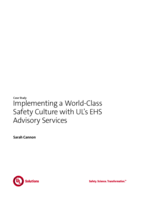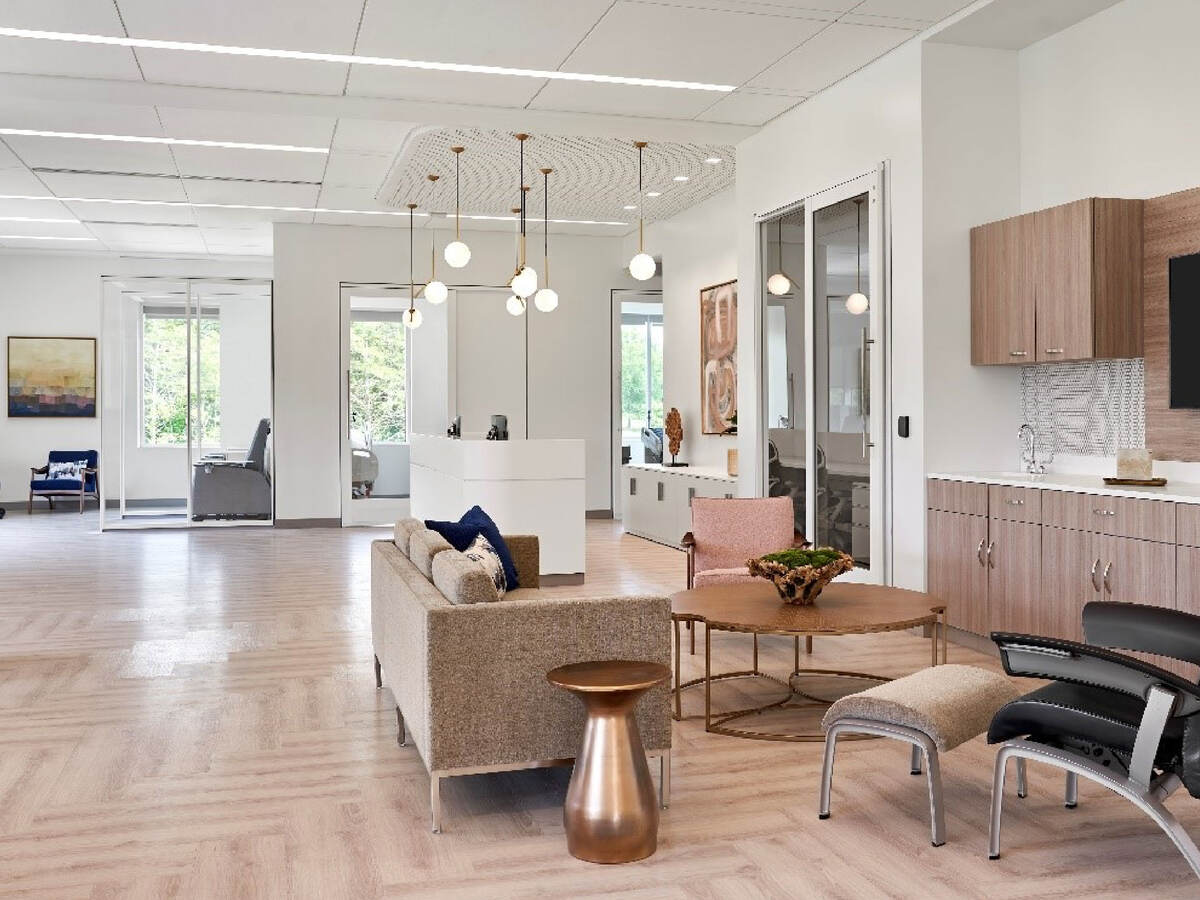
Sarah Cannon - EHS Advisory Services - Case Study
Learn how Sarah Cannon, the Cancer Institute of HCA Healthcare, trusted UL Solutions to evaluate their working spaces and review existing safety-related programs.

Sarah Cannon, the Cancer Institute of HCA Healthcare, knew that having a strong, employee safety-centered culture would help them prevent workplace accidents and injuries. The organization trusted UL Solutions to evaluate their working spaces and review existing safety-related programs. Following extensive collaboration with the UL Solutions Environmental Health and Safety (EHS) Advisory Services team, Sarah Cannon implemented a world-class EHS program and established a proactive safety culture.

Sarah Cannon was founded in 1993 as the first community-based cancer research offering outside of a university setting. In the subsequent years, Sarah Cannon pioneered the first community-based drug development program in the world, which expanded research offerings to patients seeking access to novel therapies. In 2012, Sarah Cannon became the Cancer Institute of HCA Healthcare.
Sarah Cannon provides integrated services for patients facing cancer. Their cancer programs include customized patient navigation provided by oncology-trained nurses, clinical trials and molecular profiling capabilities. The organization offers cancer care close to home for thousands of patients. To best serve patients through high-quality services, Sarah Cannon knew they needed their employees, internally referred to as colleagues, present and safe so they could take good care of patients.
In 2017, Sarah Cannon analyzed all internal safety management processes. The organization wanted to develop a strong, employee safety-centered culture for its colleagues and patients. To implement an effective, formal, written incident reporting and management system, Sarah Cannon looked for a third-party organization to conduct a workplace safety inspection and evaluate their existing safety programs.
“We built a culture of trust by completing the shift from reactive to proactive safety culture, thanks to the UL Environmental Health and Safety Advisory Services team, our engaged executive team, our colleagues and our patients’ hard work and dedication, who look out for each other.”
Sarah Cannon trusted UL Solutions , a global safety science leader, to help strengthen workplace safety and exceed regulatory compliance and internal standards. “UL is viewed as the gold standard when it comes to employee and patient safety,” said Philip Bunting, senior director of Health and Safety, Facilities, Design and Construction at Sarah Cannon. “UL’s Environmental Health and Safety Advisory Services offered a menu of services along with its global industry recognition that fit very well with our goals.”
As a healthcare provider, Sarah Cannon outlined the need to keep employee safety at the forefront to deliver high-quality care to their patients. Prior to collaborating extensively with UL Solutions, any preventive and corrective actions assigned had to occur after an incident took place. Even then, verifying if these actions had been taken to prevent future incidents from occurring wasn’t easy. To better fulfill its mission, Sarah Cannon searched for a more comprehensive way to address safety.
They engaged UL Solutions to evaluate their working spaces (clinical areas, laboratories and offices), review existing safety-related programs and observe how their colleagues practiced safety.
After analyzing the initial assessment results, UL Solutions recommended a three-phased approach. This approach addressed compliance-related issues and laid a solid foundation for Sarah Cannon’s quest to implement a high-performing, leading indicator-based, proactive safety culture.
The first phase of the project consisted mainly of gap assessment. This phase focused on addressing facility-related findings and identifying key areas for improvement in the overall safety management system. “Our initial assessment identified some potential employee safety concerns and revealed a few gaps in their safety program,” said Eric Glass, senior risk and safety advisor at UL Solutions. “There were a number of opportunities for improvements that could be accomplished in the short-term through a proactive safety culture.”
UL Solutions found opportunities for improvement in areas such as the incident reporting system, assignment of corrective and preventive actions (CAPAs), workplace safety inspections, hazard awareness and standard operating procedures (SOPs).
When UL Solutions' EHS Advisory Services team presented their findings to Sarah Cannon’s C-level executives, it had a positive impact. Sarah Cannon committed to comprehensively addressing the findings and implementing efforts to exceed those standards. “Our goal is to create a safety culture, not a safety program,” said Dee Anna Smith, CEO of Sarah Cannon, during one of their initial meetings with UL Solutions and other Sarah Cannon stakeholders. That set the tone for the entire project and solidified their determination to look at safety excellence more deeply.

During the first phase, Sarah Cannon’s team started to realize the relevance of employee health and safety. “Sarah Cannon’s biggest challenge was getting the entire organization to view employee health and safety with the same importance as patient and treatment safety,” Glass said. “We achieved this together with Sarah Cannon by helping the company account for colleague safety in every element of their operations and by identifying employee safety as the major factor in helping to ensure their mission: delivering the highest quality of care to all their patients.”
In the second phase of the project, organizational buy-in at all employee levels began taking root. With UL Solutions’ guidance, Sarah Cannon tasked key stakeholders to develop safety principles and to align those principles to existing organizational pillars, e.g., accountability, candidness, excellence and inclusiveness.
As a result of the assessment phase, one of the new leading objectives became establishing and fortifying their incident reporting and introducing formalized observation and near-miss reporting. Near miss refers to an unplanned event that has the potential to result in damages or injuries; circumventing these events represents a key step toward improving safety in the workplace. Additionally, Sarah Cannon overhauled the entire incident reporting process to accommodate other types of reports, such as injuries and illnesses, vehicle incidents, security concerns and building-related concerns.
Once Sarah Cannon enhanced the incident reporting process, the standardized approach allowed their colleagues to become part of the safety solution. Sarah Cannon set communication channels and hired the first dedicated resource to maintain colleague health and safety. Due to the increased hazard awareness, observation reporting that resulted in corrective and preventive actions significantly increased. Near-miss incidents and colleague-related injuries started to decrease.
Incident investigations also became more frequent and standardized. Although the Sarah Cannon EHS leads took overall responsibility for conducting investigations and issuing corrective and preventive actions, Sarah Cannon’s managers and front-line colleagues emerged as safety leaders as they became involved, particularly during the mitigation stages. This involvement helped ensure the completion of assigned corrective and preventive actions, better equipping Sarah Cannon to recognize the potential of future incidents. Results included more thorough investigations, accurate root cause identification and effective corrective and preventive measures.

In phase three, UL Solutions and Sarah Cannon focused on specific hazardous situations and risks that could threaten Sarah Cannon’s efforts to sustain a proactive health and safety culture. Sarah Cannon leveraged continuous education to maintain and increase their hazard awareness through leadership safety meetings, internal communication, colleague surveys and alert systems. Additionally, the organization implemented new measures, such as expanding their dedicated EHS team, using predictive analytics to develop action plans and instituting a more frequent workplace inspection program.
To implement a world-class employee EHS culture, Sarah Cannon understood the importance of complying with applicable Occupational Safety and Health Administration (OSHA) standards, the Joint Commission and U.S. Environmental Protection Agency (EPA), the International Air Transport Association (IATA)/U.S. Department of Transportation (DOT) regulations and established HCA standards. The organization aimed to exceed the requirements. Thus, Sarah Cannon developed a written safety program that addressed the compliance requirements and included guidelines, principles, a mission statement and colleagues’ roles and responsibilities in maintaining a healthy and safe working environment for colleagues, patients and visitors.
Because of a positive safety culture, Sarah Cannon started receiving more observation reports. Sarah Cannon’s teams are carrying out more inspections and deploying better training and education. More colleagues actively support the overall safety process. Sarah Cannon incorporated technology into their everyday health and safety efforts, like e-learning, recorded webinars and incident management software. “We built a culture of trust by completing the shift from reactive to proactive safety culture,” Bunting said.

Working jointly with UL Solutions’ EHS Advisory Services team proved immediate positive outcomes for Sarah Cannon. After one year of collaborating with UL Solutions, Sarah Cannon’s 2018 Annual Engagement Survey score on employees feeling safe at work increased 14%. Even though their colleagues felt safer at work, Sarah Cannon’s leadership refused to waver in their pursuit of continuous improvement.
Sarah Cannon is currently moving their uniform incident reporting from a SharePoint site to PureOHS™, UL Solutions’ safety software platform that provides web-based reporting and program management.
“Additional services, such as the implementation of PureOHS, were a direct result of the success of the initial engagement with the UL EHS Advisory Services and our multi-year collaboration,” Bunting said.
"I look back to where we were just a few years ago and where we are today. We owe everything to the UL EHS team, our engaged executive team, our colleagues and our patients’ hard work and dedication, who look out for each other."
Another observed positive impact: In just three years, Sarah Cannon recorded a 100% reduction in workers’ compensation claims and liabilities, with meaningful cost savings over the course of implementation.

Sarah Cannon - EHS Advisory Services - Case Study
Have questions, need specifics? Let's get this conversation started.